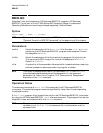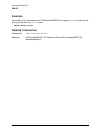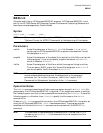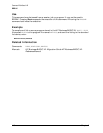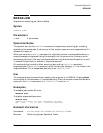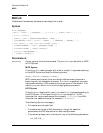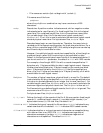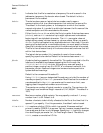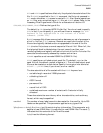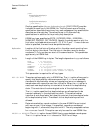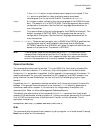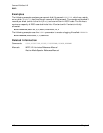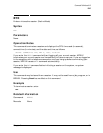
Chapter 2 113
Command Definitions A-B
BUILD
• File names can contain (but not begin with ) a dash (-).
File names are of the form
path/filename
where the path/filename combination may have a maximum of 255
characters.
recsize Record size. A positive number indicates words, while a negative number
indicates bytes for new files only. For fixed length files, this is the logical
record size. For undefined length files, this is the maximum record size.
For variable length files, this is the maximum logical record size if
blockfactor is 1. If not, this is used to calculate the maximum logical record
size and physical record size. For byte-stream files, recsize is 1 byte.
Records always begin on word boundaries. Therefore, the record size is
rounded up to the nearest word boundary for block size calculations. For a
binary file or a variable length ASCII file, odd byte lengths are rounded up
and the extra byte is available for data.
However, if an odd byte length record size is specified for a fixed length or
undefined length record file, the extra byte is not available for data.
Default is the configured physical record width of the associated device. If
you do not use the DEV= parameter, the default is DISC with 1023 records.
For example, a fixed length ASCII file with a record size specified as 11
bytes has only 11 bytes available for data in each logical record. However,
to determine actual block size, 12 bytes is used for the record size (block
size = 12 bytes multiplied by the blockfactor). If the file is specified as a
binary file, the 11 bytes are rounded up to 12 bytes (6 words), all of which
are available for each logical record.
blockfactor The number of logical records per physical block in a new file. The default
is calculated by dividing the specified recsize into the configured block size;
this value is rounded downward to an integer that is never less than 1. For
variable length record files, blockfactor and recsize are used to calculate the
maximum logical and physical record size. The blockfactor is then set to 1.
For files containing undefined length records, the blockfactor is ignored. The
maximum size of blockfactor is 255.
For byte-stream files, blockfactor is set to 1.
F, U, V or B Defines the length of the records of the file. A file may contain fixed length
records (F), undefined length records (U), variable length records (V) or
byte-stream format (B). For disk files, the default is F.
BINARY or ASCII Indicates the type of records the file contains. BINARY indicates binary
coded records and is the default. ASCII indicates ASCII coded records.
CCTL or NOCCTL Indicates whether or not carriage control characters are supplied along
with data written to an ASCII file. CCTL indicates carriage control
characters accompany the data; NOCCTL indicates carriage control
characters are not specified. The default is NOCCTL.




